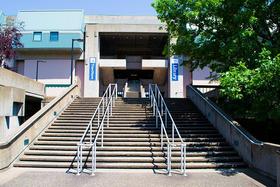- The St. Elizabeth College of Nursing is a private university located in Utica, NY, United States. The college was a product of the mission and tradition of St. Elizabeth Medical Center: with the closing of SEMC in October 2023, SECON is now a part of the Mohawk Valley Health System.
School Highlights
Saint Elizabeth College of Nursing serves 154 students (56% of students are full-time).
The college's student-teacher ratio of 5:1 is lower than the state community college average of 13:1.
Minority enrollment is 47% of the student body (majority Black and Asian), which is less than the state average of 62%.
Quick Facts (2025-26)
- Enrollment: 154 students
- Acceptance Rate: 67%
- Student-teacher ratio: 5:1
- Minority enrollment: 47%
- Source: Integrated Postsecondary Education Data System (IPEDS)
Top Rankings
Saint Elizabeth College of Nursing ranks among the top 20% of public schools in New York for:
Category
Attribute
School Resources
School Overview
The teacher population of 31 teachers has stayed relatively flat over five years.
Saint Elizabeth College of Nursing
(NY) Community College Avg.
Carnegie Classification
Special Focus Two-Year: Health Professions
Baccalaureate/Associate's Colleges: Mixed Baccalaureate/Associate's
Institution Level
At least 2 but less than 4 years
At least 2 but less than 4 years
Institution Control
Private not-for-profit
Private not-for-profit
Year Founded
1904
Total Faculty
31 staff
159 staff
School Calendar
Student Body
The student population of Saint Elizabeth College of Nursing has declined by 14% over five years.
The student-teacher ratio of 5:1 has stayed the same over five years.
The Saint Elizabeth College of Nursing diversity score of 0.60 is less than the state average of 0.76. The school's diversity has grown by 121% over five years.
Total Enrollment
154 students
1,129 students
Student-Teacher Ratio
5:1
13:1
# Full-Time Students
86 students
528 students
# Part-Time Students
68 students
601 students
# Enrollment Undergraduate
154 students
357 students
# Full-Time Undergraduate Students
86 students
519 students
# Full-Time Graduate Students
n/a
44 students
# Part-Time Undergraduate Students
68 students
850 students
# Part-Time Graduate Students
n/a
41 students
Total Dormitory Capacity
n/a
382 students
% American Indian/Alaskan
2%
n/a
% Asian
3%
8%
% Hispanic
2%
23%
% Black
3%
18%
% White
53%
38%
% Hawaiian
34%
2%
% Two or more races
1%
3%
% Non Resident races
n/a
3%
% Unknown races
n/a
5%
Diversity Score
0.60
0.76
College Completion Rate (Students who graduate in less than 4 years)
65%
25%
College Completion Rate (Students who graduate in 4 years or more than 4 years)
n/a
40%
Average Graduate Earnings (10 Years)
$55,500
$35,200
Tuition and Acceptance Rate
% Students Receiving Some Financial Aid
100%
88%
Median Debt for Graduates
$17,500
$12,000
Median Debt for Dropouts
$5,500
$5,500
Acceptance Rate
67%
74%
SAT Reading
n/a
475
SAT Math
n/a
505
SAT Writing
n/a
485
ACT Composite
n/a
20
ACT English
n/a
18
ACT Math
n/a
20
Source: 2023 (or latest year available) Integrated Postsecondary Education Data System (IPEDS) , School Administrators
Frequently Asked Questions
What is the acceptance rate of Saint Elizabeth College of Nursing?
The acceptance rate of Saint Elizabeth College of Nursing is 67%, which is lower than the state average of 74%.
What is Saint Elizabeth College of Nursing's ranking?
Saint Elizabeth College of Nursing ranks among the top 20% of community college in New York for: Percent of students receiving financial aid.
Recent Articles

Scholarships for Community College Students 2025
Explore updated scholarship programs, tuition data, and expert strategies for community college students in 2025.

The Rise of Technical and Vocational Training in 2025
Explore the 2025 surge in technical and vocational training—enrollment, policy, costs, and why this path is gaining ground for students and parents.

Stackable Credentials: How Community Colleges Advance Careers
Discover how community colleges use stackable credentials to build career pathways, boost earnings, and enable lifelong learning in 2025.






